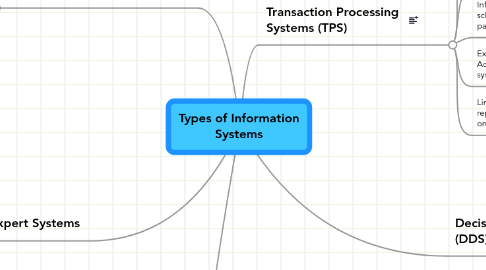
1. Management Information Systems (MIS)
1.1. Uses the Data collected by the TPS to help managers make routine business decisions.
1.2. The MIS can produce Scheduled as well as ad hoc (on demand) Reports
1.3. The MIS also produces summary reports that combines groups of total data to help with tactical and strategic planning.
1.4. The MIS can produce exception reports that contains information that is outside of normal or acceptable ranges.
1.5. Limitations Cannot provide models or projections very important strategic planning tools.
2. Expert Systems
2.1. An expert system is sometimes refereed to as a knowledge biased system.
2.1.1. It is designed to analyze data and help the used arrive at a decision.
2.2. The facts and rules of the system are usually taken from interviewing one or more expert on a subject and then incorporating that information into a knowledge base.
2.2.1. The knowledge base can be manipulated by software called an Inference Engine. this process of testing and designing the rules in a expert system is called knowledge engineering.
2.3. Designed to solve a specific problem or Domain.
2.4. The Expert system can be designed to deal with uncertainty using Fuzzy Logic.
2.4.1. Fuzzy Logic is designed to help deal with imprecise data.
2.4.1.1. Fuzzy logic uses Questions biased on certainty (EX are you 98% sure you sall that) it can then give you a approximate answer 95% sure you saw a Grey whale.
2.5. It works be analyzing the data you give it with the data it has to try and you the best answer it has.
3. Online transaction processing system
3.1. Analyzes every account entry used in real-time.
3.2. Uses Rollback to ensure that every transaction processed correctly.
3.2.1. Rollback works by checking you account before the transaction takes place to make sure no errors occur if the transaction fails the account will return to its original state.
3.3. Examples - Online banking and ATMs.
4. Transaction Processing Systems (TPS)
4.1. Provides ways to collect, store, process, display and modify Transactions most.
4.1.1. Many transactions can be entered simultaneously.
4.2. Information Collected is stored on a database.
4.3. Information can be used to make regularly scheduled reports like monthly bills, Weekly paychecks and inventory summary's.
4.4. Examples of TPS's are Payroll, Accounting, Sales and inventory systems.
4.5. Limitations of the TPS are the Detailed reports that only provide basic information on transactions.
5. Decision Support System (DDS)
5.1. Helps people make decision by directly manipulating data, analyzing data from external sources, generating statistics projections and creating models.
5.1.1. The DDSs can be used to make solve many problems because it contains a good selection of decision making tools.
5.2. A special type of (DDS) is the executive information system (EIS) designed to provide senior managers with strategic management activities like Setting policy's and planing budgets.
5.3. Decision makers use DDSs to make Decision models like the cash flow model that helps them see what desicon will be best for business
5.3.1. a Decision Model is a numerical representation of a realistic situation.
